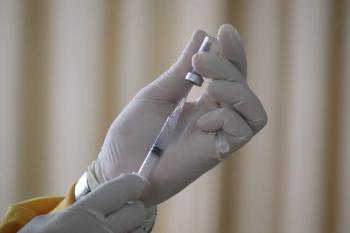
Ending the HIV Epidemic by 2030—Is Trump's SOTU Promise Feasible? Public Health Watch
The bold promise in last week’s State of the Union address is achievable, but may mean keeping the Affordable Care Act.
During last week’s
It’s an admirable goal, however, some infectious disease experts working on the frontlines of HIV/AIDS research and treatment say achieving it may mean a political pivot on several key domestic policy positions, including those related to the Affordable Care Act (ACA), LGBT rights, and women’s health care.
“No force in history has done more to advance the human condition than American freedom,” the commander-in-chief said last week on Capitol Hill. “In recent years we have made remarkable progress in the fight against HIV and AIDS. Scientific breakthroughs have brought a once-distant dream within reach. My budget will ask Democrats and Republicans to make the needed commitment to eliminate the HIV epidemic in the United States within 10 years. Together, we will defeat AIDS in America.”
Based on follow-up comments from the leadership at the US Centers for Disease Control and Prevention (CDC), the National Institutes of Health (NIH), and Health and Human Services (HHS), it seems President Trump hopes to build on the work of predecessors Bill Clinton, who significantly expanded the NIH, effectively doubling the resources allocated to HIV/AIDS research to upwards of $3 billion annually; George W. Bush, who launched
Indeed, after the speech, CDC Director Robert R. Redfield, MD, revealed that President Trump’s plan “will deploy the people and key prevention and treatment strategies needed to reduce new HIV infections by 75% over the next 5 years, with the hope of a 90% reduction within 10 years.” Part of the plan will be improving “access to comprehensive prevention and treatment, including medications that can prevent infection,” such as pre-exposure prophylaxis (PrEP) and the establishment of “HIV elimination teams—for ‘boots-on-the-ground’ support—to ensure communities with the greatest burden make progress.”
Key to making positive strides will likely be the role of PrEP, and a commentary published in the February 7th issue of the
Which is where the ACA (also known as “Obamacare”) comes in. Chris Beyrer, MD, Desmond M. Tutu Professor of Public Health and Human Rights at Johns Hopkins University’s Bloomberg School of Public Health, told Contagion® that one of the reasons why the ACA has been so important for people already living with HIV/AIDs is that it “protected persons with pre-existing conditions like HIV infection and transformed the lives of Americans living with the virus.” It also made health care insurance more affordable for millions of Americans.
Ideally, Dr. Beyrer said, the Trump administration will “expand Medicaid via the ACA” to address growing “health disparities” caused by cost and care access issues across “broad swaths” of the country, primarily the southern United States. In the past, though, President Trump has indicated that repealing the ACA is a legislative priority of his, and his administration has taken steps that have reportedly
“HIV in the south is becoming a disease of low-income people of color and we’ve got to see resources targeted there to make a difference in 2020 and get us to HIV epidemic control by 2030,” Dr. Beyrer said. “Since so many of those infections are among gay and bisexual men of color and women and transgender women of color, this won't happen without attention on LGBT rights, women's health care access, and stigma reduction. Let's hope the administration is willing to take on those tough issues.”
Jonathan A. Colasanti, MD, MSPH, assistant professor with the Division of Infectious Diseases at Emory University, said his first reaction to the SOTU announcement was cynicism, but said afterwards that “with the leadership group who is at the table, I’m optimistic that this will result in positive strides forward.”
US Surgeon General Jerome M. Adams, MD, a Trump appointee, seems to
And Alex Azar, the Trump-appointed HHS secretary, fully supports the initiative to end the HIV epidemic and intends to focus efforts on four key strategies: diagnose, treat, protect, and respond.
“The president sees a once-in-a-generation opportunity to end the epidemic, thanks to the most powerful HIV prevention and treatment tools in history and new tools that allow us to pinpoint where HIV infections are spreading most rapidly,” Azar wrote in
“[The initiative] acts boldly on this unprecedented opportunity by providing the hardest hit communities with the additional expertise, technology, and resources required to address the HIV epidemic in their communities,” Azar wrote.
According to Dr. Colasanti, the plan demonstrates “an understanding of the need for a multipronged approach.”
He added, “It’s anchored in our science around testing, linkage, and engagement in care, antiretroviral therapy, and supportive services.”
The administration has yet to reveal exact policy plans for ending the HIV/AIDS epidemic by 2030, something Dr. Colasanti describes as a “lofty but attainable” goal.
“I honestly am not sure what firm policy changes will follow,” Dr. Colasanti said, echoing the sentiments of many of his colleagues. “[The president] has promised dollars in the budget, though it’s unclear how much. What I’m certain of is that [ending] the HIV epidemic in the United States…will take a sea change in terms of erasing stigma and eliminating the discrimination that people living with HIV shoulder.”
To be continued…
Newsletter
Stay ahead of emerging infectious disease threats with expert insights and breaking research. Subscribe now to get updates delivered straight to your inbox.

















































































































































































































































































